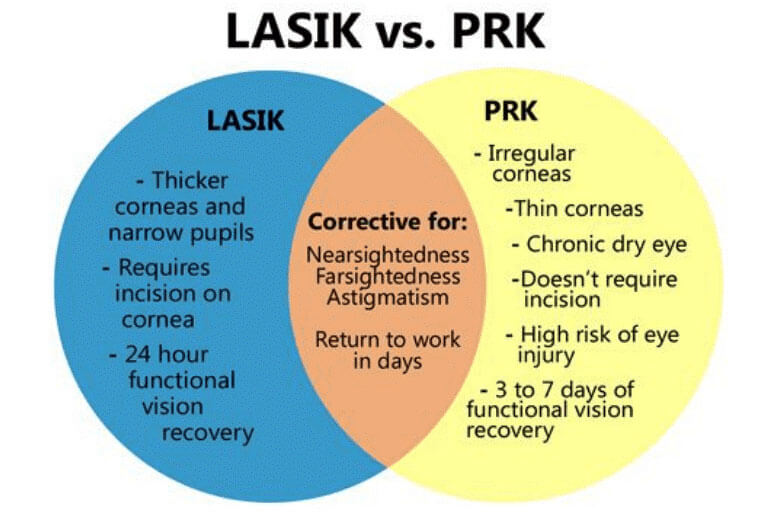Refractive Services


Photo-Refractive Keratectomy (PRK)
Before the advent of LASIK, this was the most commonly performed refractive surgery. In this procedure, the thin outer layer of the cornea is removed. Using excimer laser the cornea is then reshaped to make the light rays focus on the retina to get clear vision.
Who is eligible for PRK?
- Stable refractive error
- Patient above 18 years of age
What are the advantages of PRK over LASIK?
- Absence of corneal flap in PRK eliminates any risk of flap related complications in LASIK
- Suitable for people with intense physical activities like contact sports and athletes
- Safer for high-risk injury prone jobs like armed forces
- Ideal for individuals with thin corneas and high refractive errors
How is PRK surgery done?
- Step 1: Anesthetic drop is instilled
- Step 2: Corneal epithelial layer is removed
- Step 3: Excimer Laser is used
- Step 4: Bandage contact lens is placed to protect the eye as it heals
Will there be pain after PRK?
Those who undergo PRK have mild pain and watering in the initial period. A bandage contact lens is placed over the eyes to make you comfortable. The lubricating drops will soothe your eyes and anti-inflammatory drops will reduce eye inflammation. Maximum quantity of vision is achieved in the first week and hazy vision will improve over 2 -3 weeks.
Which is safer? PRK or LASIK?
In terms of safety profile, PRK is definitely safer than LASIK as less tissue is being manipulated during PRK. There is no flap involved in PRK unlike LASIK, hence no flap-related complications like free cap, button-hole or flap dislocation post-surgery can happen.

What care should I take after PRK?
Wear UV-protected glasses when you are in sun-exposed areas. Use anti-inflammatory, antibiotics and lubricating drops as prescribed for up to 4 weeks.
Intraocular Phakic lenses (pIOL) (ICL/IPCL)
Phakic IOL commonly referred to as ICL (Implantable Collamer Lens), are micro thin lenses which are implanted in front of the natural lens, to focus light on the retina, like glasses or contact lenses. They are permanently placed inside the eye, at its nodal point and give high-definition vision.

Who should go for ICL?
It is generally preferred in eyes that are not suitable for LASIK.
Indications include:
- Thin corneas
- High refractive powers > -8 Dioptres
- Cylinder power > 3.5 Dioptres
- Corneal diseases like keratoconus, severe dry eyes
What do we check before planning an ICL procedure?
An ICL has to fit perfectly in a space within the eye, and therefore ICL size and parameters have to be customized to the individual eye. A small-sized ICL will be loose and make it float around. A large size will make it too tight and disturb adjoining areas. It is similar to a custom-fitted bespoke suit. Even the slightest variation can disrupt final outcomes. ICL Screening is the most crucial step in the entire process. For an ICL to go within the eye, the eye should have a natural space for it. This space is called the Anterior Chamber Depth (ACD)
Are there any contraindications for ICL?
It is not suitable for patients who have less space in the anterior chamber of the eye, pregnant or breastfeeding mothers, and chronic eye diseases like glaucoma and diabetic retinopathy.
What are the possible risks of ICL procedure?
ICLs are very very safe procedures. These procedures are also US-FDA approved, which means they have been given safety clearance for Human Eyes. However, like any other surgical procedure, it can have some extremely rare complications if a proper screening check is done before the process. Some of the risks include infection, increased intraocular pressure, and the possibility of accidental damage to the crystalline lens during the procedure. Some patients may experience some discomfort during the healing process (like dry eyes, and light sensitivity), but these effects are temporary. Your doctor will discuss with you the risks and benefits of the procedure during your consultation.
How is the ICL procedure done?
You will receive numbing eye drops, and your eyes will be held open with a speculum to prevent blinking. A tiny incision will be made in your cornea, so your surgeon can implant the lens. Then, the incision will close by itself as your eyes heal. Total surgery time will be around 15 to 20 minutes per eye.

What medications should I use after ICL procedure?
You will have to use antibiotic and anti-inflammatory drops for a few weeks after surgery. Do not rub your eyes.
What are the advantages of ICL over other refractive procedures?
It gives good quality vision even with high refractive power. It is safer to do in patients who have the propensity to develop corneal disease like keratoconus or any medical condition for which laser vision correction procedures are contraindicated as it does not alter the shape of the cornea.
Recent Blogs
Resources to keep You informed with our blog


